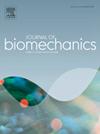Foot-body coupling angle is a strong kinematic predictor of friction requirements during ladder descent: Implications for slipping risk
IF 2.4
3区 医学
Q3 BIOPHYSICS
引用次数: 0
Abstract
Slips and falls from ladders are a common cause of workplace injuries, yet insufficient research explains the cause of these incidents. This study identifies the association between the required coefficient of friction (RCOF) and biomechanical factors (foot angle, body angle, foot-body coupling angle, foot contact velocity, foot placement, and trunk center of mass velocity) during ladder descent. In bivariate regression analyses with the ladder angle as a covariate, foot angle was negatively associated with RCOF (i.e. toe-down has a higher RCOF) (t362 = −19.8, p < 0.001). The body angle was negatively associated with RCOF (i.e. aligning the center of mass above the foot has a higher RCOF) (t323 = −3.4, p = 0.001) and there was a positive association between the foot contact velocity and the RCOF (t359 = 5.2, p < 0.001). Additionally, there was a strong association between the foot-body coupling angle and the RCOF (t323 = 21.8, p < 0.001, R2 = 0.606) in which the ladder angle had a small effect. A multivariate model supported that both the foot (t322 = −21.3, p < 0.001) and body angle (t322 = 8.2, p < 0.001) independently contributed to the RCOF, which supported the validity of the foot-body coupling angle. This work indicates that the foot-body coupling angle is a compelling metric associated with RCOF and could be used to train safer climbing techniques and monitor behavior to reduce ladder slip and fall events.
求助全文
约1分钟内获得全文
求助全文
来源期刊

Journal of biomechanics
生物-工程:生物医学
CiteScore
5.10
自引率
4.20%
发文量
345
审稿时长
1 months
期刊介绍:
The Journal of Biomechanics publishes reports of original and substantial findings using the principles of mechanics to explore biological problems. Analytical, as well as experimental papers may be submitted, and the journal accepts original articles, surveys and perspective articles (usually by Editorial invitation only), book reviews and letters to the Editor. The criteria for acceptance of manuscripts include excellence, novelty, significance, clarity, conciseness and interest to the readership.
Papers published in the journal may cover a wide range of topics in biomechanics, including, but not limited to:
-Fundamental Topics - Biomechanics of the musculoskeletal, cardiovascular, and respiratory systems, mechanics of hard and soft tissues, biofluid mechanics, mechanics of prostheses and implant-tissue interfaces, mechanics of cells.
-Cardiovascular and Respiratory Biomechanics - Mechanics of blood-flow, air-flow, mechanics of the soft tissues, flow-tissue or flow-prosthesis interactions.
-Cell Biomechanics - Biomechanic analyses of cells, membranes and sub-cellular structures; the relationship of the mechanical environment to cell and tissue response.
-Dental Biomechanics - Design and analysis of dental tissues and prostheses, mechanics of chewing.
-Functional Tissue Engineering - The role of biomechanical factors in engineered tissue replacements and regenerative medicine.
-Injury Biomechanics - Mechanics of impact and trauma, dynamics of man-machine interaction.
-Molecular Biomechanics - Mechanical analyses of biomolecules.
-Orthopedic Biomechanics - Mechanics of fracture and fracture fixation, mechanics of implants and implant fixation, mechanics of bones and joints, wear of natural and artificial joints.
-Rehabilitation Biomechanics - Analyses of gait, mechanics of prosthetics and orthotics.
-Sports Biomechanics - Mechanical analyses of sports performance.
 求助内容:
求助内容: 应助结果提醒方式:
应助结果提醒方式:


